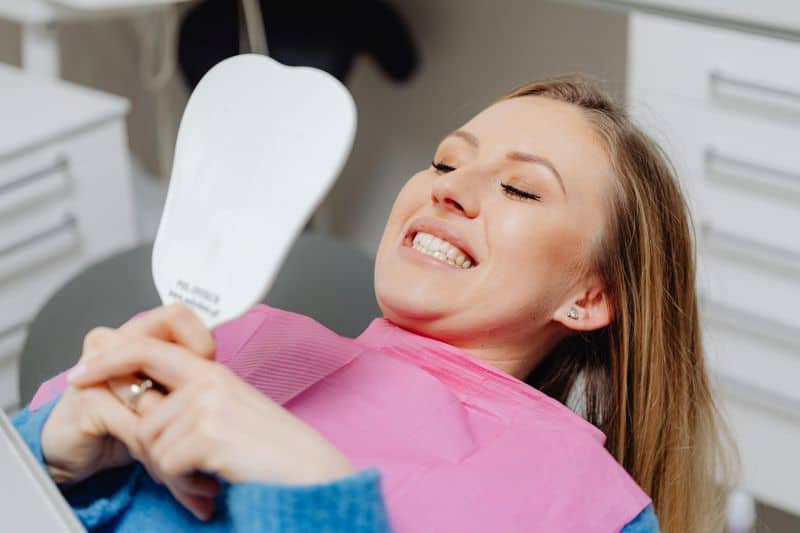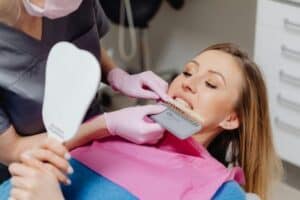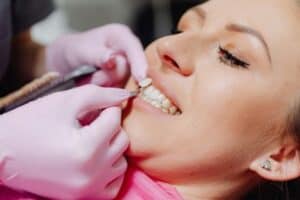
29 May DIY vs. Professional Teeth Whitening: What You Should Know
A bright, white smile can make a lasting impression. Whether you’re getting ready for an important event or simply want to feel more confident, having whiter teeth is a goal shared by many. With a wide range of options available, from at-home kits to professional dental treatments, deciding between DIY and professional teeth whitening can be confusing. This article explores the advantages and disadvantages of both approaches to help you make the best choice for your oral health and appearance.
What is Teeth Whitening?
Teeth whitening is a process that lightens the color of your teeth by removing stains and discoloration. This is typically done using bleaching agents like hydrogen peroxide or carbamide peroxide, which break down stain molecules on and within the tooth enamel. Over time, teeth naturally darken due to aging and exposure to staining substances.

How Teeth Whitening Works
When a whitening agent is applied to the teeth, it penetrates the enamel and breaks apart the compounds causing discoloration. This results in a visibly brighter smile. The level of whitening can vary based on the strength of the bleaching agent, the method used, and the severity of the stains.
Common Causes of Tooth Discoloration
Tooth discoloration can be caused by a variety of factors, including:
-
Consuming dark-colored beverages like coffee, tea, and red wine
-
Smoking or using other tobacco products
-
Poor dental hygiene
-
Aging, which thins the enamel and reveals yellow dentin underneath
-
Certain medications such as antibiotics that affect tooth development
DIY Teeth Whitening Methods
There are several over-the-counter and natural methods available for individuals looking to whiten their teeth at home. These options are more affordable but generally less powerful than professional treatments.
Whitening Toothpaste
Whitening toothpaste typically contains mild abrasives and low levels of peroxide. While it can help remove surface stains over time, it does not significantly alter the natural color of the teeth.
Whitening Strips
Whitening strips are coated with a thin layer of peroxide-based gel and are designed to be worn on the teeth once or twice a day for up to two weeks. They can provide modest results and are convenient for most users.
Natural Remedies
Some people turn to natural remedies such as brushing with baking soda, rinsing with hydrogen peroxide, or oil pulling with coconut oil. While these methods may offer some surface-level benefits, they are not as effective as chemical whitening and may not be safe for prolonged use.
Pros and Cons of DIY Teeth Whitening
DIY whitening options can be appealing due to their low cost and ease of use. However, they also come with limitations.
Pros:
-
Affordable and accessible
-
Can be done at home at your convenience
-
Useful for mild surface stains
Cons:
-
Less effective for deep or stubborn discoloration
-
Results may take longer to appear
-
Potential for misuse, leading to tooth sensitivity or gum irritation
-
Limited guidance on safety and proper application

What is Professional Teeth Whitening?
Professional teeth whitening is performed by a licensed dentist and involves the use of stronger bleaching agents. These treatments are typically faster, more effective, and tailored to the individual’s needs.
In-Office Whitening
In-office whitening involves the application of a high-concentration bleaching gel, often activated by a special light or laser. The procedure usually lasts about an hour and can make teeth several shades whiter in a single visit.
Dentist-Prescribed At-Home Kits
These kits include custom-fitted trays and stronger whitening gel than over-the-counter options. Though applied at home, they offer professional-level results and are monitored by your dentist for safety.
Pros and Cons of Professional Whitening
Professional whitening delivers superior results, but it’s not without its own set of considerations.
Pros:
-
Fast and noticeable results
-
Supervised by a dental professional
-
Customizable to individual needs
-
Safer application, especially for those with sensitive teeth
Cons:
-
More expensive than DIY options
-
May cause temporary sensitivity
-
Requires an appointment and time investment
Key Differences Between DIY and Professional Whitening
The choice between DIY and professional whitening comes down to several key differences in cost, effectiveness, safety, and time.
Cost:
DIY products are generally much cheaper, ranging from $5 to $60, while professional treatments can cost between $300 and $1,000 depending on the method and provider.
Time:
DIY whitening requires repeated use over several days or weeks. Professional treatments can produce visible results in just one session.
Effectiveness:
Professional whitening can significantly brighten teeth and treat deeper stains. DIY methods are more limited and generally only effective for surface-level discoloration.
Safety:
DIY methods carry a higher risk of improper use, which can lead to enamel damage or gum irritation. Professional treatments are safer due to the guidance and supervision of a dentist.
How to Choose the Right Option
Choosing between DIY and professional whitening depends on your specific needs, budget, and dental history.
-
If your stains are mild and you’re looking for a cost-effective solution, DIY products may be sufficient.
-
If you’re seeking dramatic results, have sensitive teeth, or want a safer, faster option, professional whitening is likely the better choice.
It’s also a good idea to consult with your dentist before starting any whitening regimen. They can evaluate your oral health and recommend the most appropriate method.
Common Myths About Teeth Whitening
“Whitening damages your teeth.”
When used correctly, whitening products approved by dental professionals do not harm tooth enamel.
“Natural remedies are safer.”
While they may seem harmless, some natural remedies like lemon juice or baking soda can be abrasive and damage enamel over time.
“Whitening lasts forever.”
Whitening results are not permanent. Lifestyle habits, such as drinking coffee or smoking, can cause teeth to become discolored again.
“All teeth respond the same.”
Teeth with intrinsic stains or restorations such as crowns and veneers may not respond to whitening.
“The more product you use, the better.”
Overusing whitening products can cause sensitivity and damage. Always follow recommended guidelines.

Frequently Asked Questions
Is teeth whitening safe?
Yes, especially when done under the supervision of a dental professional. Over-the-counter products are generally safe when used correctly.
How long do whitening results last?
Results can last anywhere from 6 months to 2 years depending on your diet, oral hygiene, and smoking habits.
Can I whiten my teeth if I have dental work?
Whitening agents do not affect crowns, veneers, or fillings. You should consult your dentist for advice tailored to your dental work.
What are the side effects of teeth whitening?
Some people experience temporary sensitivity or mild gum irritation. These effects usually go away after a short time.
How often can I whiten my teeth?
It’s generally safe to whiten your teeth once every 6 to 12 months. Overuse can lead to enamel damage.
Is it better to do whitening at home or in a dental office?
Each method has its pros and cons. Professional whitening is faster and more effective, while DIY methods are cheaper and more convenient.
Conclusion: Which Whitening Method is Right for You?
Deciding between DIY and professional teeth whitening depends on your goals, budget, and oral health. If you’re looking for immediate, long-lasting results and are willing to invest, professional whitening is the superior option. On the other hand, if you’re just beginning your whitening journey and prefer a more affordable route, DIY methods can offer moderate improvements.
Whatever method you choose, maintaining good oral hygiene, limiting stain-causing foods and drinks, and visiting your dentist regularly will help you keep your smile looking its best.


Sorry, the comment form is closed at this time.